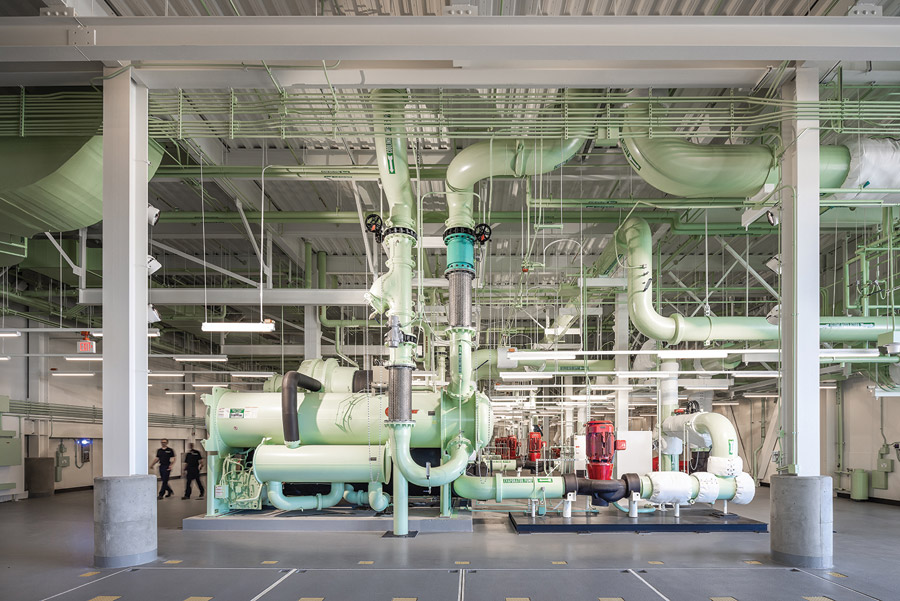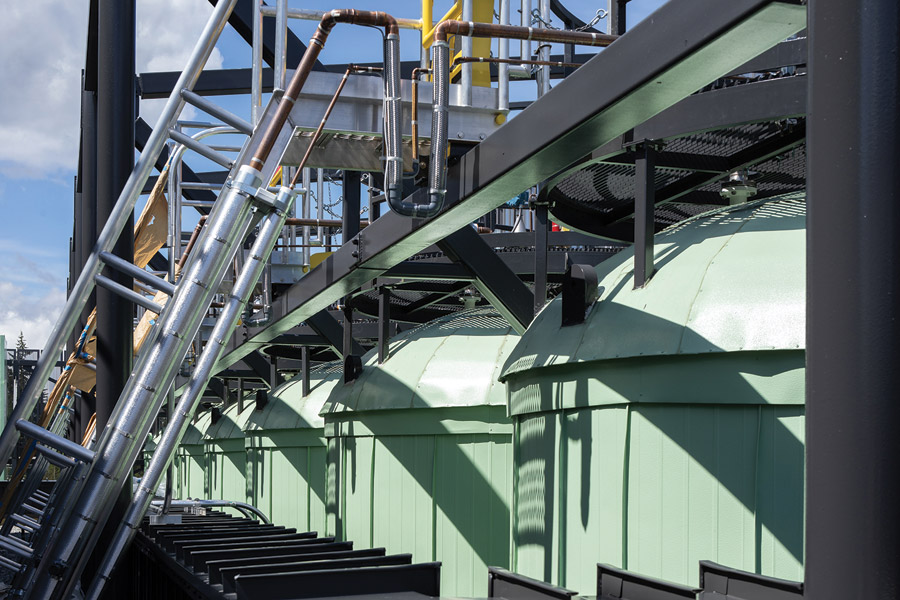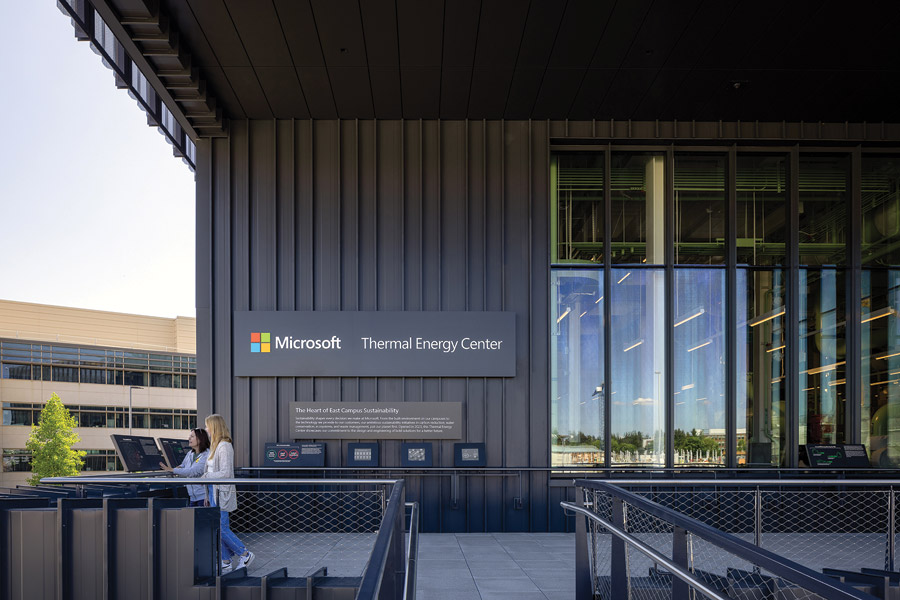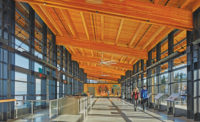Microsoft Thermal Energy Center
Redmond, Wash.
BEST PROJECT, MANUFACTURING, and Award of Merit, Sustainability
KEY PLAYERS
Submitted by: GLY Construction
Owner: Microsoft
Lead Design Firm: NBBJ
General Contractor: GLY Construction
Civil/Structural Engineer: Coughlin Porter Lundeen
MEP Engineer: AEI
Waterproofing Design: Morrison Hershfield
Low Voltage and AV Design: Stantec
Owner's Representative: OAC Services
Commissioning Authority: Glumac
Microsoft’s Thermal Energy Center provides more than heating and cooling for the tech giant’s headquarters in Redmond, Wash. It’s a source of pride for the engineering, design and construction team behind the project.
“From Day 1, the team rolled up their sleeves and collaboratively created the most efficient design that met the project goals,” says Jeff Rovegno, senior development manager for Microsoft Real Estate and Facilities.
Located in the heart of the company’s new 72-acre East Campus, the green energy utility plant has been dubbed the “Machine in the Woods,” with a three-story operational hub that is green in form and in function. The center draws the bulk of its energy from more than 900 connected geowells (50 for backup), drilled to a depth of 550 ft over 6.5 acres—creating one of the largest geoexchange fields in the country and a first for a company to build its own, according to project representatives. Inside the hub—which features solar panels and backup generators—heat recovery chillers, thermal wells and 65-ft thermal energy storage tanks are centralized as one system running on renewable electricity.
“By operating under different modes and utilizing the diversity in the system design, we can run the plant 50% more efficiently than a standard [central utility plant],” says Rovegno. Additionally, the facility aims to cut campus water-usage by 8 million gallons per year and support Microsoft's goal to be carbon negative by 2030. “Centralizing the heating and cooling to one building enables a more efficient design and mode of operations,” Rovegno says.
Completed July 2022, the plant is part of Microsoft’s campus modernization plan to control building occupancy settings throughout 3 million sq ft of new office space and in two existing critical buildings. Although the campus’ 17 newer buildings originally called for individual utility units powered by natural gas, close collaboration and careful logistics enabled the project team to deftly pivot to geoexchange technology.
Working through procurement, scheduling and construction challenges, Rovegno says a design-assist project delivery model and the team’s experience with the alternative project delivery methods helped ensure constructibility and meet project goals with no onsite use of fossil fuels for daily operations and the efficient use of water and energy-efficient building envelopes and systems.
“To meet these targets,” Rovegno explains, “the design team developed several options for mechanical systems that could provide the required efficiencies with varying upfront costs, serviceability and space requirements.”
At every step, having a team committed to putting what’s best for the project first made it a success, says owner representative Mike Green, senior project manager at OAC Services. “Bottom to top, everyone knew their role and did it very well,” says Green. “A project that spans four years and everyone still has smiles at the end including the architect, engineer and owner is rare.”

More than half of the MEP scope of the project was prefabricated, saving the project team time and reducing onsite errors and associated costs.
Photo by Sean Airhart/NBBJ
Collaboration & Coordination
Influencing design, engineering and the construction schedule throughout was the project’s prefabrication strategy. With AEI, GLY and MacDonald Miller (MMFS) collaborating on MEP design—plus some creative scheduling to support offsite fabrication—the team condensed six weeks of onsite work into five days of prefabrication work. The MEP scope represented more than 60% of the overall project cost, and the project team estimates achieving $15 million in mechanical redundancy cost savings from prefabrication.
“The combined design solutions provide a showcase and educational tool for learning about this one-of-kind system and Microsoft's sustainability effort.”
—Margaret Montgomery, Project Sustainability Lead, NBBJ
Offsite prefabrication also reduced the number of workers driving to and from the site, reducing associated fuel emissions and onsite errors.
“The most significant design choice made by the team to support prefabrication was the decision to stack the chillers on Levels 1 and 2,” says Ben Hamm, senior project manager at GLY. He explains that preliminary designs showed the chillers on the first floor and pumps on the second floor—which would have resulted in a web of piping that required piece-by-piece installation and a significant amount of field welds.
As a result, the overall length of piping and array of pumps was reduced, allowing mechanical trade partner MacDonald Miller to shift production to their shop, saving on field labor and increasing quality control.
In place of a pipe riser installation sequence at the jobsite, MMFS proposed a modular riser that could be set independently ahead of the primary structure being set in place.
“This was months of work that was able to be installed in days on site,” says Mark Krewedl, MMFS vice president of operations. “This prefab was built into the designs from early on and a lot of work went in between contractors and designers that allowed us to coordinate and sequence the setting of the larger modules during the erection sequence of the primary structure.” He adds, “In other words, the TEC building structure was strategically built to support the load-in of prefabricated racks and equipment skids.”
Hamm says a design decision to separate the location of mechanical and electrical systems by respective floors—mechanical on Levels 1, 2 and 3 and electrical on Levels 1, 1.5 and 2.5—also nearly eliminated the risk of trade partners working on top of each other. “Each team essentially had its own zones to work in, which allowed GLY to sequence much of the work independently and not have to wait for start-to-finish relationships to resolve themselves,” says Hamm.

The geowell team worked from a thorough plan that included coordinating with different contract teams to gain site access for drilling while navigating days that exceeded 100 degrees and other days with snow on the ground.
Photo by Sean Airhart/NBBJ
It’s Not Easy Being Green
The carbon neutral design and construction was one of the integral aspects of the project—both in terms of design and construction, says Margaret Montgomery of NBBJ, the project’s lead design firm.
“In addition to the large reduced carbon emissions energy savings that the [TEC] provides to every building on the 72-acre site, the embodied carbon of the building itself was tracked and reduced to less than half what a typical central utility plant would be,” Montgomery says. “And the construction process needed to look closely at each product and material that went into the building to maintain this rigor.”
Using the embodied carbon in construction (EC3) tool, NBBJ tracked the embodied carbon of the building materials during design, and GLY kept track of resulting material purchases and the carbon output of jobsite activities. Further reducing greenhouse gas emissions, the team practiced waste diversion and used electric heaters and lifts, solar-powered LED site lighting and renewable diesel in waste hauling trucks.
“The use of metal screening and roof penthouse orientation provides a unifying roof profile, allowing proper air circulation for cooling towers and minimizing their noise impact to the surrounding area,” explains Montgomery. To articulate the center’s systems and ensure access and space for maintenance, “an exterior bridge and porch, along with specifically located curtain wall and interactive architectural lighting, were designed to allow the employees and their guests to see the (geoexchange system) piping and tanks,” she says.
Lastly, “a unique green color against a monochrome exterior and interior was selected to highlight the various mechanical systems,” says Montgomery. “The combined design solutions provide a showcase and educational tool for learning about this one-of-kind system and Microsoft’s sustainability effort.”

An educational exhibit at the TEC building beckons employees and campus visitors to learn more about the center’s power technology and how it advances Microsoft’s sustainability initiatives.
Photo by Sean Airhart/NBBJ
Digging Deeper
Conventionally, geowells are installed in a flat, empty area without having to coordinate underground piping systems around utilities. However, due to the unconventional location of Microsoft’s geoexchange field, 3D modeling and a detailed review of as-built drawings and investigative groundwork ahead of drilling helped to plan and pivot around existing underground infrastructure from previous office buildings on the more than 6-acre space. It also helped avoid tree destruction.
“As you can imagine, conditions can vary greatly over 6 acres,” says GLY project manager Mike Martel. “On top of navigating the potential risks associated with the previous and existing elements, there were miles of new utilities being installed concurrent to the (gowell bore) for the remainder of the new 72-acre campus.”
The new utilities included domestic water lines, electrical power, stormwater vaults, shoring walls and other elements under another GC’s scope of work.
“Depending on the location on site, these wells and vaults could be under future softball fields, cricket fields, gardens and fire lanes,” says Martel. As a result, the geowell team had to “understand and preplan for what may be required for these future spaces,” he says.
Moreover, coordinating and planning efforts were not done in isolation. “The larger project team, which included the other general contractors on campus modernization, modeled every known element and reviewed together in 3D prior to any work starting,” says Martel. “This allowed different project teams and decision-makers to assess the different systems in 3D and make design adjustments as needed ahead of time to avoid conflicts—with a single focus on what was best for Microsoft.”
On site, drilling not under GLY’s area of care and custody required coordination with the other general contractors to gain access to the work area.
“This required an accurate schedule to meet our obligation to the other project partners on a constant basis,” says Martel. “This was a constant coordination dance for two years together.”
He adds, “GLY Construction is very proud of the coordination and the unique solutions implemented to navigate the challenges and reduce risk in order to deliver a (geoexchange system) field of this scale on schedule and budget.”



---Urban-Mining-Industries-Pozzotive_ENRready.jpg?height=200&t=1663257031&width=200)


Post a comment to this article
Report Abusive Comment